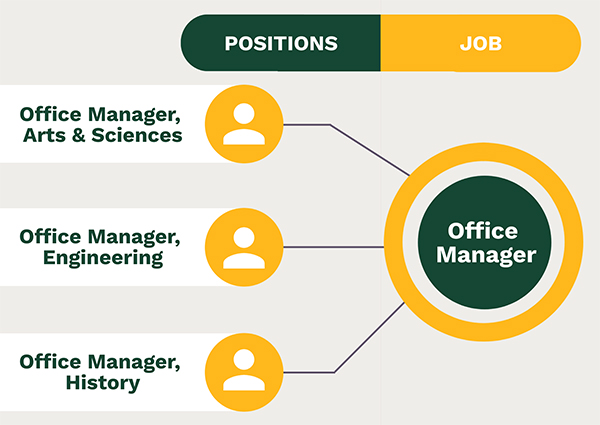What to Know about Job Profiles & Pay Grades

A leader recently asked to know more about job profiles and how they correlate to pay bands in order to better understand compensation decisions when hiring, considering a promotion and working through merit pay allocation.
What is a Job?
A job is a grouping of similar positions. An example of this is an Office Manager. All the Office Manager positions across the University are grouped together to one job. The duties of their position may vary slightly depending on the area they support, but overall, they are all performing Office Manager duties.

There are two things that describe a job.
- Job Profile
- Pay Grade
What is a Job Profile?
Every job has a job profile tied to it. A job profile is an abbreviated job description used to communicate the high-level duties of a job and the requirements, including experience and education. Job profiles can be found within Ignite using the following path: Me > Career and Performance > Career Development > Explore Careers.
A job description, on the other hand, would have the full duties listed for a position and may be specific to that department or school. It is recommended that each area keep full updated job descriptions for their employees in case there becomes a need to backfill an existing position, or a new position is created. The template for a job description can be found here. Using the department provided job description, HR will use our job profiles to see where the position would most closely align, which would in turn, determine the pay grade.
What is a Pay Grade?
Just like each job has a job profile, each job also has a pay grade assigned to it. Baylor has 16 different pay grades. Each grade has a minimum and maximum amount and this range is called a pay band. We use these pay grades to make sure we are paying jobs that require the same experience, education, and job duties similarly. For example, the Office Manager job is on pay grade 3 and all Office Managers across the University are paid within that pay band. Baylor also utilizes wide ranges for our pay bands to account for slight pay differentiation for many different factors including tenure, experience and performance.
What do I need to know as a manager?
VacanciesWhen a new position is created or newly vacated, you, as the manager, will work with your assigned HRC to create a job description, if one is not already created. The job description will then be provided to the compensation team. The compensation team looks at several different factors when determining a compensation recommendation including job profiles, market data and current employee data to align with internal equity while remaining externally competitive.
PromotionsIf you feel that a promotion is warranted, you will need to work with your HR Consultant (HRC) to provide justification. A job description outlining the differences will be needed for the HRC and compensation team to assess.
Performance IncreasesWhen an employee is performing at a high level, any pay increases should be awarded through our annual merit cycle. By providing performance increases through merit, we are promoting Baylor's pay for performance culture. When you complete the merit worksheet in Ignite, you will have a recommended merit range, which is based off the employee's performance score and where they fall on their pay band.
For more information regarding Baylor University's pay structure and compensation philosophy, please visit the compensation webpage.
